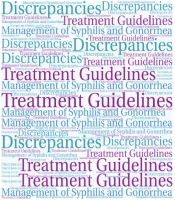Dear Editor,
The incidence of bacterial sexually transmitted infections (STIs) [especially syphilis and gonorrhea] is on an upsurge mode throughout the world. Most often, patients with the cardiovascular, central nervous system, and ocular manifestations with reactive serology for syphilis and also complicated cases of gonococcal infections (epididymitis, paraurethritis, and tysonitis in men and Bartholin’s abscess in women apart from pelvic inflammatory disease [PID]) are referred to STI practitioners for management. Even though many guidelines are available for the management of STIs (e.g., CDC, world health organization (WHO), IUSTI, Australian, and NACO: National AIDS Control Organization in India), there is no consensual opinion with regard to certain management requirements. The guidelines issued by WHO (1) are followed by most countries all over the world; however, these guidelines have not been revised recently. On the other hand, CDC guidelines (2) suffer from some discrepancies causing a STI practitioner difficulties applying them to manage STIs confidently.
Situations Put in the Dilemma
Syphilis can be treated to the point of presumptive cure as per the textbooks because there is no definite test confirming cure (3). Although we rarely come across cases of CVS, CNS syphilis, ophthalmic syphilis, and complicated gonorrhea in our today’s practice, we are likely to face a surge in the incidence of these cases in future.
(1) Late syphilis is defined as the prolongation of the disease for more than one (as per CDC guidelines) (2) or two (as per WHO guidelines (1) and most traditional text books (3)) years. So, the confusion starts here as the treatment and dosage schedules for both early and late syphilis vary in different guidelines;
(2) There is no mention of treatment for cardiovascular syphilis in none of the guidelines. Coronary ostial stenosis and syphilitic aneurysms still occur sporadically. The routine three weekly doses of benzathine and penicillin 2.4 megaunits will not be sufficient, and CVS syphilis will be better to manage with higher daily doses of short-acting penicillin rather than the depot preparation. Moreover, the Jarisch Herxheimer reaction and the incidence of therapeutic paradox will be dreadful consequences of treatment. So, measures for preventing such consequences should be mentioned in these guidelines.
With regards to the management of CNS syphilis, there is no mention in WHO guidelines, which only have addressed the management of late syphilis alone with three weekly injections of benzathine penicillin 2.4 mega units. It is obvious that benzathine penicillin cannot penetrate the blood brain barrier, and we need to use high intravenous doses of aqueous benzyl penicillin G every four hours;
(4) Although the recent issue has been addressed in CDC guidelines, there are also some dilemmas there. It is recommended to inject 3 - 4 million units of aqueous benzyl penicillin every four hours (18 - 24 million per day) for 10 - 14 days. The wide range in the dosage given may leave the practitioner confused about whether he/she can use 3 or 4 million units every four hours or whether or not he/she can complete the treatment within 10 days or extend up to 14 days. Otherwise, can we inject procaine penicillin 2.4 megaunits along with probenecid tablets for 10 - 14 days?? Should it be for 10 days or up to 14 days?;
(5) When the patient has sensitivity to penicillin, ceftrixone injection (1 - 2 grams/day) for 10 - 14 days is recommended. Once again, the wide range places the healthcare provider in a dilemma of whether to use 1 g or 2 g and whether to continue treatment for 10 or 14 days;
(6) In cases of gonorrhea, the WHO recommends injecting ceftrixone (250 mg statum dose) for uncomplicated gonorrhea, and in the case of treatment failure, it is recommended to inject ceftrixone 500 mg statum or administer cefixime tablets (800 mg statum dose). Also, the CDC recommends injecting ceftrixone 500 mg statum for uncomplicated cases of gonorrhea as the first line of therapy. In WHO’s guidelines, the recommended treatment is available for ophthalmia neonatorum but not for other complications of gonococcal infections. The CDC provides guidelines for treating disseminated gonococcal infections, meningitis, endocarditis, and arthritis, but not for other complications of gonococcal infections like epididymitis, tysonoitis, paraurethral duct infection, and paraurethral abscess in men and Bartholin’s abscess and skeinitis in women;
(7) Similarly, some other discrepancies can be mentioned in the therapeutic guidelines of other bacterial STIs (leaving viral STIs);
(8) In the follow-up of syphilis, text books (3) advise keeping the individual under supervision for up to two years, after which a lumbar puncture can be performed to examine the CSF to rule out any CNS involvement before one can proclaim that the individual is syphilis-free. On the other hand, CDC guidelines (2) do not require CSF examination to exclude the diagnosis in the absence of symptoms pertaining to CNS syphilis;
(9) In most of my cases of late and late-latent syphilis, even after adequate and recommended treatment, the nonspecific serological markers of syphilis remained persistent for more than 3 - 5 years without any decrease in the titer. Have we to consider this as treatment failure or not? If yes, how to proceed without any clear-cut guidelines? How can we convince patients and referring physicians?;
(10) Similarly, with regard to viral STIs, physicians are facing many difficulties. In the cases of HPV-associated genital warts, what is the first line treatment? Is there any systemic drug available? Is chemical cauterization preferred or cryotherapy or any other surgical procedure, or even electric ablation? What about immune-modulent measures?;
(11) Also, regarding the HSV-2 infection, no measures are known to prevent disease recurrence, a problem that disrupts marital life and becomes very anxious during day-to-day activities and pregnancy.
If we are able to develop a universal consensual guideline with clear-cut dosage schedules for STI management that can be accepted by all experts, it will be of great help to everyone in the field. If necessary, we have to gear up research work to reach consensual management.
